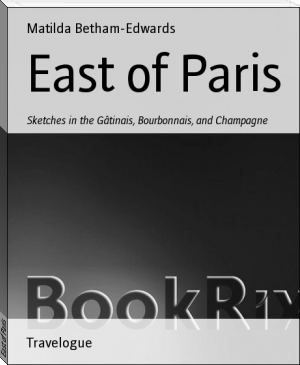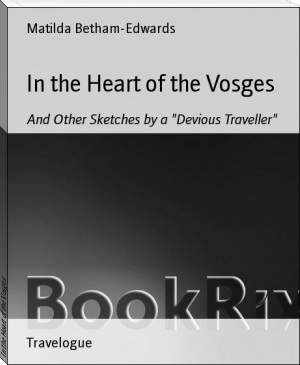East of Paris by Matilda Betham-Edwards (microsoft ebook reader TXT) 📖

- Author: Matilda Betham-Edwards
Book online «East of Paris by Matilda Betham-Edwards (microsoft ebook reader TXT) 📖». Author Matilda Betham-Edwards
How she wormed herself into the confidence of the Cardinal de Rohan, a man of the world and of education, would seem wholly unaccountable but for one fact. The Prince Primate had faith in Cagliostro and his nostrums, and when an individual has recourse to astrologers and fortune-tellers, we are quite in a position to gauge his mental condition. Like Mdlle. Couesdon of contemporary fame, Cagliostro held intercourse with the angel Gabriel, but his occult powers and privileges far exceeded those of the Parisian lady-seer. He was actually in the habit of dining with Henri IV., and two days before the Cardinal's arrest made his client believe that he had just accepted such an invitation!
It had been Rohan's ambition to obtain the favour of the Queen and a foremost position at court, hence the readiness with which he fell into the trap. For "the Valois orphan," now Comtesse de la Motte, not only possessed great personal attractions, but an extraordinary gift of persuasiveness. Without much apparent trouble she made the Cardinal believe that she was in the Queen's favour, and indeed in her confidence. Having got so far the rest was easy.
How the acquisition of the already celebrated Diamond Necklace was first thought of, how, by the aid of willing tools, she matured and carried out her deep-laid and diabolical scheme, reads like an adventure from the "Arabian Nights." The personification of the Queen by a little dressmaker who happened to resemble her, the forgery of the Royal signature, the final attainment of the diamonds, all seemed so easy to this consummate trickster that it is small wonder she became intoxicated with success and blind to consequences. No sooner was the necklace in her possession than, of course, as fast as possible it was turned, not into money, but into money's worth. Houses and lands, equipages and furniture, costly apparel, and delicacies for the table were purchased, not with louis d'or, but with diamonds.
We read of her triumphant entry into the little town of Bar-sur-Aube, cradle of the Saint Remy-Valois family, in a berline with white trappings and the Valois armorials, before and behind the carriage, which was drawn by "four English horses with short tails," rode lacqueys, whilst on the footboard ready to open the door stood a negro, "covered, from head to foot with silver." Still more dazzling was the dress of Madame la Comtesse, richest brocade trimmed with rubies and emeralds. As to the Count, not content with having rings on every finger he wore four gold watch chains! Besides holding open house when at home, the pair had a table always spread with dainties for those who chose to partake in their hosts' absence. Among the toys paid for in diamonds was an automatic bird that warbled and flapped its wings. This was intended for the amusement of visitors.
The carnival proved of short duration. It was on the 1st of February, 1783, that the diamond necklace was handed over to Madame de la Motte, Rohan receiving in return the forged signature of "Marie-Antoinette de France." On August of the same year, in the midst of a banquet given at Bar-sur-Aube, a visitor arrived with startling news. "The Prince Cardinal de Rohan, Grand Almoner of France, was on the Festival of Assumption, arrested in pontifical robes, charged with having purchased a diamond necklace in the name of the Queen."
The charm of these little French towns and rustic spots lies in their remoteness, the feeling they give us of being so entirely aloof from familiar surroundings. In many a small Breton or Norman town we hear little else but English speech, and in the one general shop of tiny villages see _The New York Herald_ on sale. But from the time of leaving Nemours to that of reaching the farthest point mentioned in these sketches we encounter no English or American tourists. This essentially foreign atmosphere is not less agreeable than conducive to instruction. We are thus thrown into direct contact with the country people and are enabled to realise French modes of life and thought.
CHAPTER XVIII.
ST. JEAN DE LOSNE.
Within the last twenty-five years so many new lines of railway have been opened in France that there is no longer any inducement--I am inclined to say excuse--for keeping to the main road. Yet, strangely enough, English tourists mostly ignore such opportunities. For one fellow-countryman we meet on the route described here, hundreds are encountered on the time-honoured roads running straight from Paris to Switzerland. Quit Dijon by any other way and the English-speaking world is lost sight of, perhaps more completely than anywhere else on the civilised globe. Again and again it has happened to myself to be regarded in rural France as a kind of curiosity, the first subject of Queen Victoria ever met with; again and again I have spent days, nay weeks, on French soil, the sole reminder of my native land being the daily paper posted in London. It is now many years since I first visited St. Jean de Losne, in company of a French acquaintance, a notary, both of us being bound to a country-house on the Saone. At that time the railway did not connect it with Dijon, and in brilliant September weather we jogged along by diligence, a pleasant five hours' journey enough. My companion, a native of the Cote d'Or, seemed to know everyone we passed on the way, whenever we stopped to change horses getting out for a gossip with this friend and that he had taken the precaution to provide himself with a huge loaf of bread, from which he hacked off morsels for us both from time to time. As we had started at seven o'clock in the morning, and got no dejeuner till past noon, the doles were acceptable. The fellow-traveller of that first journey--alas! With how many friends of the wine country!--has long since gone to his rest. The second time I set forth alone, taking my seat in the slow--the very slow--train running alongside the Canal de Bourgogne. On the central platforms of the Dijon railway station, crowds of English and American tourists were hurrying to their trains, bound respectively for Paris and Geneva. No sooner was I fairly off, my fellow travellers being two or three country-folks, than the conventionalities of travel had vanished. Surroundings as well as scenery became entirely French.
The Burgundian character is very affable, and although people may wonder what can be your errand in remote regions, they never show their curiosity after disagreeable fashion. They are delighted to discover that interest in France--artistic, economic, or industrial-- has led you thither, and will afford any assistance or information in their power. They seem to regard the wayfaring Britisher as whimsical, that is all.
A train that crawls has this advantage, we can see everything by the way, villages, crops, and methods of cultivation. The landscape soon changes. The familiar characteristics of the wine country disappear. Instead of vine-clad hills, nurseries of young plants grafted on American stocks, and vineyard after vineyard in rich maturity, we now see hop gardens, colza fields, and wide pastures. Here and there we obtain a glimpse of some walled-in farmhouse, recalling the granges of our own Isle of Wight.
Alongside the railway runs the canal, that important waterway connecting the Seine with the Saone; but the Saone itself, Mr. Hamerton's favourite river, is not seen till we reach our destination.
The little town of St. Jean de Losne, although unknown to English readers, is one of the most historic of France. No other, indeed, boasts of more honourable renown. As Jeanne d'Arc had done just two centuries before, St. Jean de Losne saved the country in 1636. When the Imperial forces under Galas attempted the occupation of Burgundy, the dauntless townsfolk long held the enemy at bay and compelled final retreat. After generations profited by this heroism. Until the great year of 1789, the town, by royal edict, enjoyed complete immunity from taxation. On the outbreak of the Revolution, with true patriotic spirit, the citizens surrendered those privileges, of their own free will sharing the public burdens.
The first sight that meets the eye on entering St. Jean de Losne is the monument erected in commemoration of the siege. "Better late than never," is a proverb applicable to public as well as private affairs of conscience.
A little farther, and we reach the church of St. Jean. It contains a magnificent pulpit, carved from a single block of rich red marble, the niches ornamented with charming statuettes of the apostles. Close by is the Hotel de Ville, in which are some interesting historic relics. As I passed through the courtyard, I saw an odd sight. One might have fancied that a second Imperial army threatened a siege, and that the townsfolk were laying in stores. The pavement was piled with bread and meat, whilst butchers and bakers were busily engaged in dividing these into portions, authorities, municipal, military and police, looking on.
I learned that these rations were for the regiments quartered in the town during the autumn manoeuvres. Every day such distributions take place; in country places the troops have recourse to the peasants, very often being treated as guests. A young friend, serving his three years, told me that nowhere had he found country folk more hospitable than in the Cote d'Or. No sooner did the soldiers make their appearance in a village, than forth came the inhabitants to welcome them, officers being carried off to chateaux, men by twos and threes to the home of cure or small owner. "Not a peasant," he said, "but would bring up a bottle of good wine from his cellar, and often after dinner we would get up a dance out of doors. On the saddle sometimes from two in the morning till twelve at noon, the kind reception and the jollity of the evening made up for the hardship and fatigue. We have just had several days of bad weather, and had to sleep on straw in barns and outhouses, wherever indeed shelter was to be had. Not one of us ever lost heart or temper; we remained gay as larks all the time."
An hour's railway journey from St. Jean de Losne takes the traveller to Lons-le-Saulnier, beautifully situated at the foot of the Jura range on the threshold of wild and romantic scenery.
A decade had not robbed this little town of its old-world look familiar to me, but meantime a new Lons-le-Saulnier had sprung up. Since my first visit a handsome bathing establishment has been built, with casino, concert-room, and all the other essentials of an inland watering-place. The waters are especially recommended for skin affections, gout, and rheumatism. Formerly the mineral springs of Lons, as the townsfolk lazily call the place, were chiefly frequented by residents and near neighbours. Improved accommodation, increased accessibility, cheapened travel and additional attractions, have changed matters. The season opening in May, and lasting till the end of October, is now patronised by hundreds of visitors from all parts of eastern France. These health resorts are much more sociable than our own. Folks drop alike social, political, and religious differences for the time being, and cultivate the art of being agreeable as only French people can. Excursions, picnics, and pleasure parties are arranged; in the evening the young folks dance whilst their elders play a rubber of whist, chat, look on, or make marriages. Many a





Comments (0)